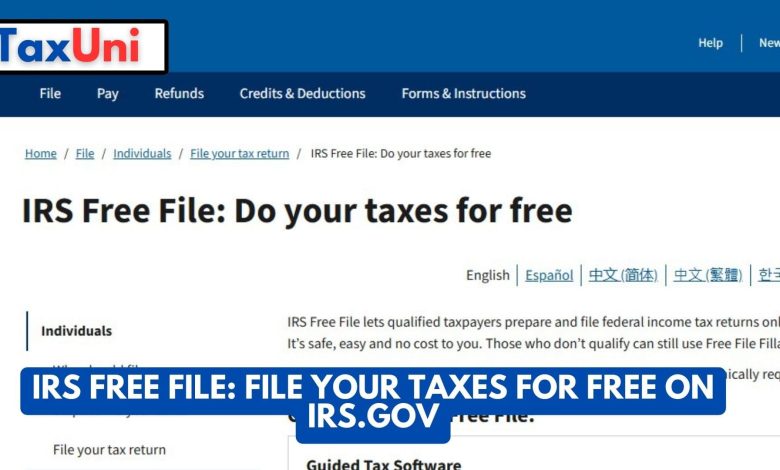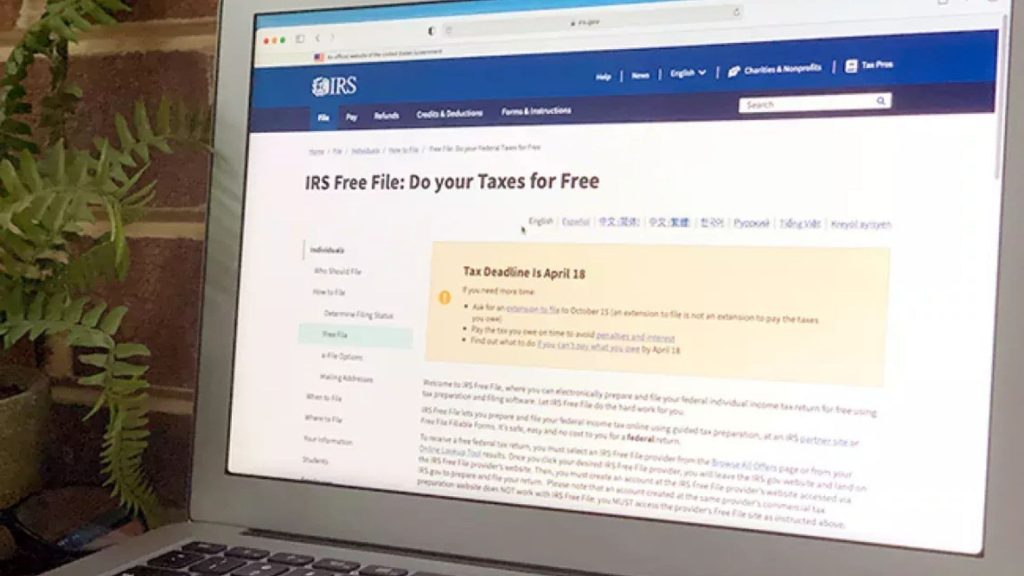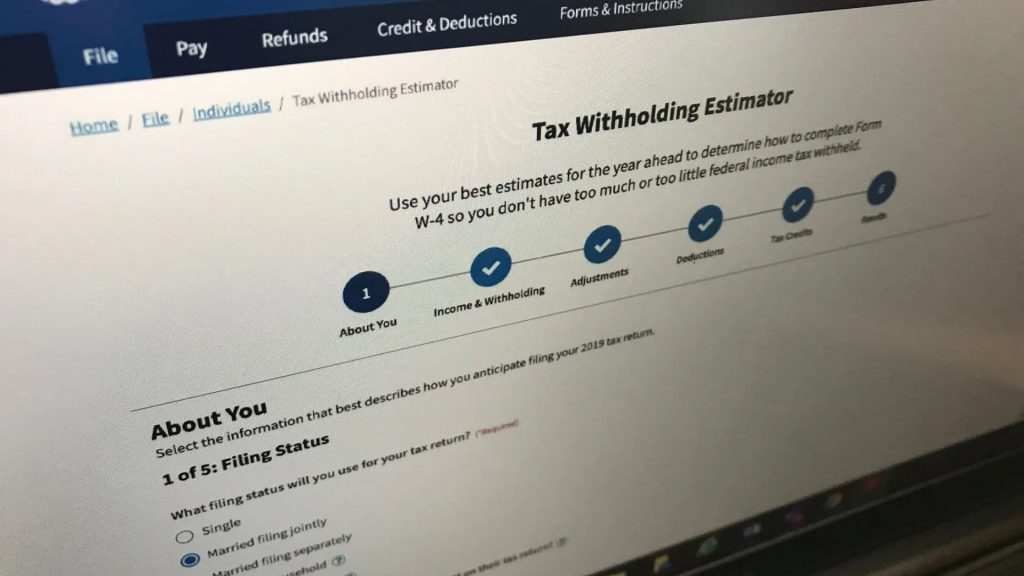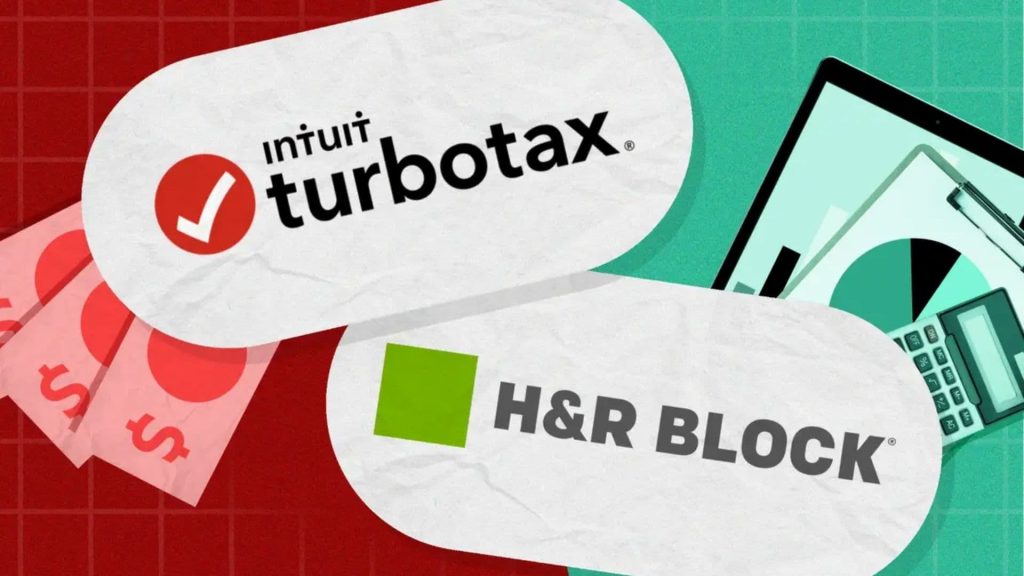
The IRS Free File program is a partnership between the IRS and private tax software companies to offer free online tax preparation and e-filing for eligible taxpayers. In simple terms, it lets you use brand-name tax software at no charge to prepare and submit your federal income tax return. Imagine doing your taxes without paying for TurboTax or H&R Block – that’s exactly what IRS Free File makes possible. It’s available on the official IRS.gov website and is designed to be safe, easy, and free for those who qualify. In this guide, we’ll explain what IRS Free File is, who qualifies, how it works, and give you a step-by-step guide to using it. We’ll also compare IRS Free File vs. TurboTax Free Edition vs. H&R Block Free Online, so you can see which free tax-filing option best fits your needs.
What Is the IRS Free File Program?
IRS Free File is a program on IRS.gov that provides free online tax preparation and filing for taxpayers under a certain income level. It’s essentially a public-private partnership: the IRS works with reputable tax software providers (through an alliance called Free File Inc., formerly the Free File Alliance) to offer their software for free to eligible users. These are the same types of software you’d normally pay to use, but through IRS Free File, they cost you nothing. According to the Free File program, about 70% of all taxpayers – roughly 100 million people – are eligible to file their federal taxes at no charge each year via IRS Free File.
The goal is to make tax filing accessible and affordable (read: $0) for people who need it most. If you qualify, you can choose from several well-known tax software brands (for example, TaxAct, TaxSlayer, FreeTaxUSA, and more) to prepare your return online, guided by prompts just like in their paid versions. The software will handle all the calculations and forms for you, for free. Note: The IRS Free File program only covers your federal tax return for $0. Some (but not all) Free File partner companies also offer free state tax returns as part of their offer – we’ll touch on that later. If a free state return isn’t available, you might be given the option to pay for state filing, or you can manually file your state return separately.

Who Qualifies for IRS Free File?
Eligibility for IRS Free File mainly depends on your income. The program is aimed at low to moderate-income taxpayers. For the current tax season, you qualify if your Adjusted Gross Income (AGI) is below the set threshold. For example, for the 2024 tax year (filing in 2025), anyone who earned $84,000 or less in 2024 is eligible to use IRS Free File. This income limit applies to all filing statuses (single, married, etc.) and is based on AGI, not gross income – AGI is basically your income after certain deductions.
In practical terms, an $84,000 AGI limit means roughly 70% of taxpayers fall under the cap. If you’re a single filer, married couple, or head of household with income at or below that level, you likely qualify. Active-duty military personnel who meet the income requirement also qualify (some Free File partners even have special offers for military filers). Age isn’t a barrier; seniors, students, and first-time filers can use Free File as long as their income is within range.
It’s important to note that each Free File partner software may have its own specific eligibility criteria. While the IRS sets a general income cap (e.g. $84k), the individual companies sometimes target narrower groups. For instance, one software provider might only serve taxpayers below a lower income or within a certain age range, or they might cover specific states. The IRS Free File portal will show you each provider’s criteria. Generally, if you fit any one of the offers, you can use the program. The IRS says that taxpayers (including military) under the income limit “can likely find an offer… that matches their needs”. And if your income is above the Free File limit, don’t fret – you won’t get to use the partner software for free, but you can still file without paid software by using Free File Fillable Forms, which is the IRS’s do-it-yourself online forms option open to everyone. (More on that in a moment.)
What If I Don’t Qualify?
If your income is too high (above the threshold) or you don’t meet any provider’s criteria, IRS Free File Fillable Forms are available as an alternative. This is basically the electronic version of paper tax forms. It’s free for any income level, but far more hands-on – essentially, you input your numbers into digital IRS forms without the friendly question-and-answer software interface. There are no built-in guides or calculations beyond basic math, and it only covers federal (no state forms). Free Fillable Forms are best for confident filers who understand tax forms or have very straightforward returns, since it won’t walk you through the process. If that doesn’t sound appealing, and you don’t qualify for a Free File software offer, you might consider other options like the Volunteer Income Tax Assistance (VITA) program for in-person help, or the commercial “free editions” (which we’ll compare later). The bottom line: Anyone can file for free one way or another, even if it means using the fillable forms or another service.

How Does IRS Free File Work?
The IRS Free File system is set up to be pretty user-friendly. Here’s an overview of how it works:
- Accessible through IRS.gov: To use Free File, you must start at the IRS Free File webpage – that’s where you see the list of partner offers. (If you go directly to a tax software’s website, you won’t get the special Free File deal, and they might try to charge you or upsell you.) So always begin on IRS.gov/FreeFile.
- Choose a Free File partner: The IRS Free File page will show multiple tax software providers that are offering free returns through the program. You can browse the offers or use the IRS’s online lookup tool to find one that fits your situation. The lookup tool asks a few questions (like your income, age, state, and any special credits) and then suggests which software offers you qualify for. Alternatively, you can manually read through each provider’s criteria – for example, some have lower income caps or certain states they serve. Pick the one that you like best that matches your needs (for instance, if one provider offers a free state return for your state, that might be a good choice).
- Link out to the software: Once you select a provider on the IRS site, you’ll click a link that says something like “Continue to [Provider]” or “Leave IRS site.” This will send you to the chosen company’s website (with a special referral so they know you’re a Free File user). Do not go to the software site separately and sign up, or you may end up in the wrong (paid) product. Going through the IRS link ensures you get the free filing offer.
- Create an account & prepare your return: You’ll need to create a login on the chosen tax software (if you don’t already have one). From there, you use it just like normal tax software: answer the interview questions, fill in your income details (W-2s, 1099s, etc.), and let it populate the forms. The software will check for deductions and credits you qualify for. It’s the full preparation process, but with $0 pricing as long as you stay within the Free File criteria. The interface is the same as that company’s usual product – for example, if you use TaxAct through Free File, it’ll look like TaxAct’s regular online software.
- File your taxes electronically: After filling out all your info, the software will allow you to electronically file (e-file) your return to the IRS. Since this is an online program, e-filing is included (that’s the only way Free File works – you’re not printing and mailing). You can typically also opt for direct deposit of any refund, which the IRS highly encourages for speed.
- Get confirmation: Once you submit, you should receive an email notification when the IRS accepts your return (this usually happens within 24-48 hours). If there’s an issue (say, a typo in a Social Security number), the return might be rejected and the software will alert you so you can fix and resend it. Assuming all goes well, you’re done with your federal filing at no cost.
- State returns: During the prep, the software will also handle your state return if it supports your state. Some Free File partners offer free state tax filing for certain states or for all states, while others might charge a fee or not support state filing at all. The IRS Free File page or the software’s info will tell you if state is included. (For example, one partner might say free federal + free state for certain states, another might say free federal + $14.99 per state, etc.) Always double-check before finalizing, so you’re not caught off guard by a state fee. You can choose to only file federal via Free File and do your state elsewhere if that works better for you.
In summary, IRS Free File works like using TurboTax or similar online software – except you access it through IRS.gov and pay $0 for federal (and potentially $0 for state). Next, let’s walk through the exact steps to use IRS Free File, so you know how to get started.

How to Use IRS Free File: Step-by-Step Guide
Filing your taxes with IRS Free File is straightforward. Follow these steps to take advantage of this free service:
- Check your eligibility: Verify that your income is within the Free File limit (for example, AGI $84,000 or below for the latest tax year) and note any other criteria that might affect you (such as age or state residency for certain providers). Essentially, if your income is under the threshold, you’re good to go for at least one of the offers.
- Gather your documents: Just as with any tax filing, collect all your necessary paperwork before you begin. This includes W-2 forms from employers, 1099 forms (for any freelance, contract, or miscellaneous income, as well as 1099-INT for interest, 1099-G for unemployment, etc.), and documentation for any deductions or credits (like tuition statements for education credits, or receipts if you have deductible expenses). Having last year’s tax return on hand is also helpful, especially because you might need last year’s AGI to electronically sign your return.
- Go to the IRS Free File page: Navigate to IRS.gov/FreeFile (the official IRS Free File portal). On that page, look for the section to “Choose an IRS Free File Offer” or the Free File Online Lookup Tool. This is your gateway to all the free software options.
- Choose a free filing software provider: You have two ways to do this:
- Use the Online Lookup Tool: Click on the IRS’s Free File Online Lookup Tool and answer a few quick questions (about your filing status, income, state, etc.). The tool will then show you which partner software offers you qualify for. This is an easy way to narrow down the list.
- Browse the Offers Manually: Alternatively, scroll through the list of IRS Free File partners on the page. For each, review their eligibility requirements (each company’s offer will say something like “Free for AGI between X and Y, age above/below Z, and resident of these states” or “Free for anyone under ___ with any state return,” etc.). Also note which ones include a free state return for your state, if that’s important to you.
- Select a provider and click through from IRS.gov: Once you’ve identified the best free software for your situation, click the link provided on the IRS site to go to that provider’s Free File website. It might say “Begin [Provider]” or “Continue” – this will have a special referral so the software knows not to charge you. You’ll typically see a notice that you are leaving IRS.gov. Proceed to the partner site.
- Create an account on the partner site (or log in): If it’s your first time using that software, you’ll need to register an account with a username/password. If you used it last year (even through Free File), you can log in to your existing account – returning Free File users often get an email reminder from the IRS or the company each year. Make sure you’re in the right “Free File” version (look for some IRS Free File branding or confirmation on the software’s page). The interface should indicate that it’s the free version for IRS Free File (not just a generic “free edition” that might later ask for payment).
- Fill out your tax return: Follow the on-screen prompts to enter your tax information. The software will ask about your income, dependents, deductions, etc. Since it’s guided, you can simply answer the questions and the program will fill in the forms. It will also do the math and check for errors or missing info. Take your time and make sure everything is accurate. The experience is the same as using that company’s paid product – the only difference is the price ($0).
- Review and file for free: When you reach the end of the preparation, the software will give you a chance to review your entire return. Double-check that all the info is correct. The price for federal (and state, if applicable) should show as $0. If the software unexpectedly shows a fee, you may have fallen out of the Free File criteria (for instance, your income or situation might not meet that provider’s free requirements). If that happens and you believe you do qualify, ensure you started through the IRS Free File site and selected the right product – you might need to start over with a different provider if something went wrong. Assuming all looks good, go ahead and electronically file your federal return for free. You’ll get a confirmation on the screen that it was submitted.
- Watch for confirmation emails: After filing, keep an eye on your email. You should receive an IRS confirmation email within a day or two, letting you know that your return was accepted. If there are issues (maybe you mistyped a Social Security Number or a name doesn’t match), the software will email you that the IRS rejected the submission. Don’t panic – in that case, log back in, fix the issue, and re-send the return (still for free). Once accepted, congrats – you’ve filed your taxes via IRS Free File! You can print or save a copy of your return for your records. If you’re getting a refund, you can track it using the IRS “Where’s My Refund?” tool. If you owe taxes, you can pay electronically through IRS Direct Pay or other methods.
That’s it. You’ve successfully used IRS Free File, and you didn’t pay a cent in software or filing fees. Now, let’s compare this experience to other popular free filing options you might be considering, like the free versions offered by TurboTax and H&R Block.

IRS Free File vs. TurboTax Free Edition vs. H&R Block Free Online
You might wonder how IRS Free File stacks up against the well-known “free” versions of commercial tax software such as TurboTax Free Edition or H&R Block Free Online. All of these options promise a $0 federal tax filing, but they have different requirements and limitations. Here’s a comparison to help you decide which route to take:
- Availability & Eligibility: IRS Free File is available to a broader group by income, whereas TurboTax’s and H&R Block’s free versions are more limited by tax complexity. If your income is under the IRS Free File threshold (e.g. $84k), you have access to the Free File program regardless of how simple or complex your return is – you just need to find a partner software that supports your forms. By contrast, TurboTax Free Edition and H&R Block Free Online do not have explicit income limits (you could earn well above $84k and still use them) but they only handle very simple tax situations. For example, TurboTax Free Edition supports only Form 1040 with no schedules beyond a few basic credits (earned income credit, child tax credit, and student loan interest are allowed, but that’s about it). If you have any itemized deductions, business income, unemployment income, or other tax forms, TurboTax’s free tier will prompt you to upgrade and pay. In fact, TurboTax’s free tier typically covers only about 30-40% of taxpayers – roughly 37% of filers are eligible by their estimation, because as soon as your return gets slightly complex, it’s no longer free. H&R Block’s Free Online is a bit more generous on what it covers: it allows Form 1040 plus limited versions of Schedules 1, 2, and 3, which means it can handle things like unemployment income, certain retirement distributions, and the student loan interest deduction that flow through those schedules. H&R Block advertises that its free tier supports more forms and thus “accepts more forms for free than the TurboTax Free Edition”, making it usable by a larger share of people. Still, if you have self-employment income (Schedule C) or other complex scenarios, even H&R Block will bump you out of free.
- Tax Forms and Situations Covered: The IRS Free File program, through its various partner software, can potentially handle more complex tax situations as long as you meet the income requirements. Some Free File partner software will let you file a return with a Schedule C (self-employment) or other less-common forms for free, which the commercial free editions would not. For example, a freelance designer or Uber driver with modest income (<$84k) might find a Free File software that supports Schedule C for free (one of the Free File partners, like OLT or FreeTaxUSA, often covers self-employment). TurboTax Free Edition explicitly excludes self-employment (no Schedule C), itemized deductions (no Schedule A), stock sales (no Schedule D), etc., and H&R Block Free also excludes self-employment and many other complexities beyond those limited schedules. In short, IRS Free File can accommodate a wider variety of tax scenarios (since at least one of its partner offers is likely to support the form you need), whereas TurboTax and H&R Block’s free tiers are only for the simplest returns. If you’re a W-2 employee with maybe a child and some student loan interest, all three options could work for you. But if you have a more complicated return (say, you’re a small business owner, or you have rental income), TurboTax/H&R free will not work, but IRS Free File might, provided your income isn’t too high.
- State Tax Returns: All three options generally support state returns, but whether it’s free depends. TurboTax Free Edition and H&R Block Free Online do include a free state return in their free tier (one state per federal return) – so if you qualify to use their free tier, you can file your state for free as well. With IRS Free File, some partner software include free state prep for certain states or all states, while others don’t. You’ll have to check each Free File offer. If your state isn’t free under the program, you might have to pay the partner’s fee for state or manually file your state return on your own. The good news is several IRS Free File partners do offer at least some states at no cost (and a few, like FreeTaxUSA in the Free File program, may cover all states for free). Always read the fine print for the provider you choose, especially if you have a state return.
- User Experience: Using TurboTax or H&R Block’s free editions can be very straightforward for beginners – these products are known for their friendly interview style and polished interface. The IRS Free File experience will vary depending on which partner’s software you pick. Some of the Free File partner softwares (like TaxSlayer or TaxAct) have interfaces comparable to TurboTax and H&R Block since they are commercial products. Others, like OLT or 1040Now, might be a bit more bare-bones. Overall, if you go through IRS Free File, you might not get the same slick design or upsell offers to live help that TurboTax provides, but you’re also avoiding the potential “upgrade traps” of the commercial sites. And remember: if you start on TurboTax Free Edition and midway through the software determines your return isn’t eligible for free, you’ll face a paywall and may feel pressured to pay to finish. With IRS Free File, if you qualify and pick the right partner, you won’t suddenly be charged – the key is making sure you match with the correct free offer from the start.
- Trust and Security: All the options discussed are relatively secure and authorized for e-filing. IRS Free File partners are vetted companies under the Free File program – the IRS doesn’t endorse one over another, but it does ensure they adhere to privacy rules. By law, the Free File partner companies cannot use or share your tax info for anything other than preparing your return without your consent. TurboTax and H&R Block are also bound by privacy laws, though there have been past concerns (highlighted in news reports) about how some companies have handled data. In terms of trust, using a Free File partner via the IRS site is about as safe as using any major tax software. The data transmission to the IRS is encrypted, and your information is protected during filing.
Which should you choose? It depends on your situation:
- If your taxes are very simple (say, just a W-2 and maybe unemployment or a small amount of interest) and you don’t mind using a big-name service, TurboTax Free Edition or H&R Block Free Online might do the job quickly with a polished interface. Just be sure your situation truly stays within their free criteria (no surprises). H&R Block’s free tier will cover a bit more than TurboTax’s (for example, H&R Block Free can handle unemployment income and a few more credits that TurboTax Free might not).
- If your return is a bit more complex (but your income is under the limit), IRS Free File will likely be the better option because you can find a software that covers your needs without cost. It’s especially useful for people with moderate incomes who have things like education credits, a small side gig, or other forms that knock them out of the commercial free tiers. For example, a student with a part-time self-employment gig could use an IRS Free File option that supports Schedule C, whereas TurboTax would charge for that.
- Also, if you simply like knowing you’re going through an IRS-supported channel and want to avoid any upselling, IRS Free File provides that peace of mind. TurboTax and H&R Block will continually suggest upgrades or add-ons (like audit defense, paid live help, etc.)—just decline them if you truly want a free file.
In many cases, IRS Free File comes out on top for value because it can handle more for free if you’re eligible. But it requires a bit more legwork to choose the right partner and navigate a potentially less famous interface. Meanwhile, TurboTax and H&R Block’s free offerings are easy to use but very limited in scope.
One more thing to note: the IRS has also launched a new pilot program called IRS Direct File (as of 2024) that allows some taxpayers to file directly with the IRS for free, without going through a private company. However, it’s currently limited to certain states and simpler returns. Most people will still be using either IRS Free File or a commercial software. It’s good to stay aware of these developments as the IRS is moving toward more free filing options in the future.

FAQs
Q: Is IRS Free File really free?
A: Yes – if you qualify based on your income (and any specific provider criteria), IRS Free File costs $0 to prepare and e-file your federal tax return. There are no hidden fees for the federal return. Some providers even include state returns for free (check each offer). As long as you access the program through the IRS.gov Free File portal and meet the requirements, you won’t be charged to file. It’s an official IRS program, so you can trust that the “free” really means free.
Q: Is it safe to use IRS Free File?
A: Absolutely. IRS Free File is safe and secure. The IRS only partners with trusted tax software companies that must adhere to strict privacy and security rules. When you file through Free File, your information is encrypted and protected from unauthorized access during transmission to the IRS. The partner companies are not allowed to use or share your tax data for other purposes without your consent. In short, your data’s security is taken seriously. Just make sure you’re using the official IRS Free File site to select a provider, and you’ll be in good hands.
Q: Does IRS Free File include state tax returns?
A: Sometimes. All IRS Free File offers cover at least your federal return for free. Whether your state return is free depends on the provider and your state. Some Free File partners offer free state returns for certain states or for all users under the income limit, while others might charge a fee or not support certain states. On the IRS Free File page, each provider’s listing will note if a free state return is included. If your state isn’t covered for free, you can still use that software for your federal return (free) and then choose to pay the software’s fee for state, or you could even file your state through another free method (for example, some states have their own free filing portals, or you might use a different company’s free tier if it supports your state). Also, H&R Block Free Online and TurboTax Free Edition both offer free state filing only if your federal return qualifies to be free on their platforms. Always double-check the details for your situation, but rest assured your federal filing will be free with IRS Free File, and state might be a bonus if offered.
Q: What if I started with TurboTax or H&R Block and they want to charge me?
A: This is common if your tax situation goes beyond what those free versions cover. If you find yourself facing an upgrade fee on TurboTax or H&R Block, and you want to avoid paying, you can still switch to IRS Free File (if your income qualifies). Save the work you’ve done, and head over to IRS.gov/FreeFile to find a partner software that supports all the forms in your return. You might have to re-enter your info in the new software, but it could save you money. In many cases, people start on a commercial “free” product and discover their situation isn’t supported for free (for example, you need to file a Schedule C for self-employment). When that happens, it’s a good cue to try IRS Free File’s options or another truly free service. Also, note that the IRS Free File tool won’t automatically import data from TurboTax or H&R Block, but some software (like TaxSlayer or TaxAct) might allow you to import a PDF of your return. Even if not, the extra time may be worth the savings.